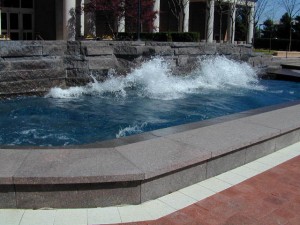One of the most fascinating pieces of public art in Silver Spring is “Coastline,” a sculpted water feature by Jim Sanborn, which is tucked into the plaza near the National Oceanic and Atmospheric Administration at 1301 East-West Highway. For those who know it is there – mostly office workers from the surrounding complex – it is a wonderful place to relax during lunch or coffee breaks. And the lucky kids who come across the piece are transfixed by the threat and prospect of being hit by the spray of the surf.
The sculpture: A large, pneumatically activated pool that sends waves crashing into stacked, sculpted red granite, creating an intense sound and sense of dynamism to which most water features – fountains that flow from one level to another or spray uniformly into the air – pale in comparison. Another fascinating aspect of the piece is that it is tied to actual wave height data being instantly transmitted from the Wood’s Hole, Massachusetts monitoring station. Imagine being at the edge of the Atlantic hearing the surf booming against the beach and rocks. Pause. You’re actually in downtown Silver Spring.
The problem: A great, interactive piece of art that appeals to our sense of play and intellect sits above sidewalk grade, away from typical pedestrian routes, screened by plantings and benches. This functions more like a private amenity, although it is supposed to benefit the larger public. (Density was awarded to the surrounding development above what would typically be allowed in exchange for this sculpture and other public amenities.)
Lessons learned: Public amenities need to be convenient and reachable, not just legally accessible. They need to be located on pedestrian routes; visible from adjacent properties, open spaces, and sidewalks; and supported by synergistic uses and activities (retail, information kiosks, restaurants, events). In sum, the landscape, the artwork, and the architectural environment need to be integrated into how space – the immediate and contextual space – is traversed and activated. This is our charge and our responsibility for projects that provide public art as an amenity.
Visit Jim Sandborn’s website to learn more about the artist and Downtown Silver Spring’s website to learn more about the project.


Jerry A. McCoy
The more important problem with this work of “public” art is that it is literally turned OFF in the evening and on the weekends when the office workers are not there! The power is turned off, the waves stop pounding, and all one sees is a pool of water.
Wayne Phyillaier
Another “public amenity” that I find as not very public is the garden at Discovery Headquarters, along Wayne Avenue. It is set behind an imposing fence, and although the gates may be open to the public it is set back behind the fence in a way that makes me feel very unwelcome whenever I have visited the garden. I hardly ever see anyone enter the garden. I think it was designed mainly to give the Discovery workers a pleasant view from their office windows.
Stuart
This non-Ghermezian wave pool is awesome, but definitely “hidden”. In a way, that makes it even cooler when you bring visitors up to it, like it is a special secret.
I did not know about the woods hole connection. That’s neat.
Btw, this is an interesting blog. Keep it up!